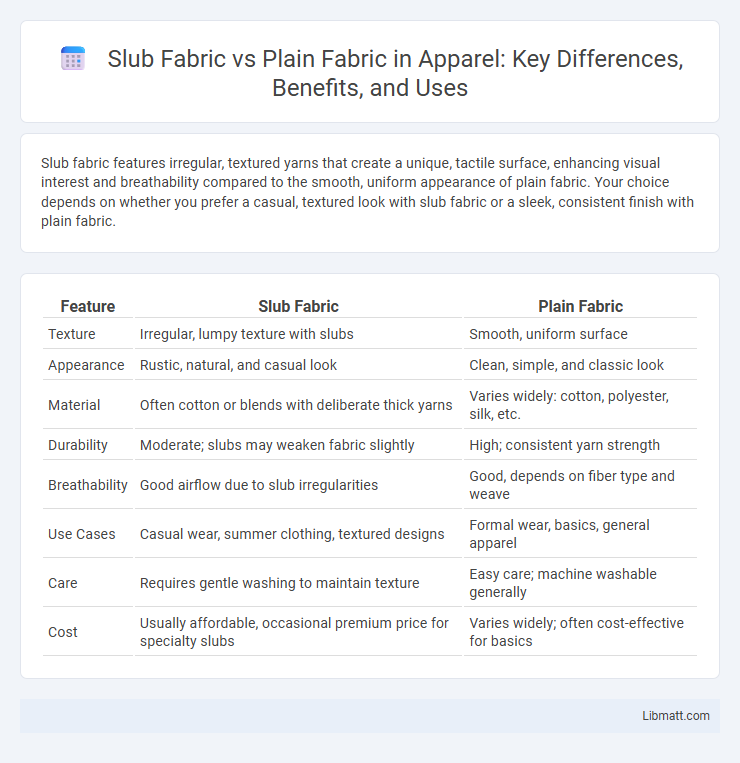Slub fabric features irregular, textured yarns that create a unique, tactile surface, enhancing visual interest and breathability compared to the smooth, uniform appearance of plain fabric. Your choice depends on whether you prefer a casual, textured look with slub fabric or a sleek, consistent finish with plain fabric.
Table of Comparison
| Feature | Slub Fabric | Plain Fabric |
|---|---|---|
| Texture | Irregular, lumpy texture with slubs | Smooth, uniform surface |
| Appearance | Rustic, natural, and casual look | Clean, simple, and classic look |
| Material | Often cotton or blends with deliberate thick yarns | Varies widely: cotton, polyester, silk, etc. |
| Durability | Moderate; slubs may weaken fabric slightly | High; consistent yarn strength |
| Breathability | Good airflow due to slub irregularities | Good, depends on fiber type and weave |
| Use Cases | Casual wear, summer clothing, textured designs | Formal wear, basics, general apparel |
| Care | Requires gentle washing to maintain texture | Easy care; machine washable generally |
| Cost | Usually affordable, occasional premium price for specialty slubs | Varies widely; often cost-effective for basics |
Introduction to Slub Fabric and Plain Fabric
Slub fabric features irregular thicknesses and subtle texture variations, created by intentionally uneven yarns during weaving, offering a unique, tactile surface ideal for casual and artistic apparel. Plain fabric, characterized by its uniform weave and smooth texture, provides consistent strength and appearance, commonly used in formal clothing and home textiles. The distinctive slub yarns add visual interest and organic appeal, contrasting the clean, structured look of plain weave fabrics.
Defining Slub Fabric: Characteristics and Creation
Slub fabric is characterized by its irregular, textured appearance created by intentionally varying the thickness of yarns during spinning, resulting in unique slubs or lumps throughout the material. Unlike plain fabric, which is woven with uniformly smooth yarns to produce an even surface, slub fabric showcases a natural, organic texture that adds visual interest and tactile appeal. Your choice between these fabrics depends on the desired aesthetic and the texture you want for your garments or home textiles.
What is Plain Fabric? Key Features Explained
Plain fabric, also known as plain weave, is the simplest and most common textile structure characterized by a tight, even interlacing of warp and weft threads, resulting in a smooth, uniform surface. Key features include durability, balanced strength, and versatility, making it ideal for a wide range of applications from clothing to home textiles. Your choice of plain fabric ensures consistent texture and reliable performance in everyday use.
Texture Comparison: Slub vs Plain Fabric
Slub fabric features irregular, raised knots that create a textured, tactile surface, offering a natural, rustic feel unlike plain fabric's smooth, uniform weave. The uneven texture of slub fabric enhances visual interest and breathability, making it ideal for casual, relaxed clothing. Your choice between slub and plain fabric depends on whether you prioritize a distinctive texture or sleek simplicity in your textile.
Visual Appeal: Aesthetic Differences
Slub fabric features irregular, textured yarns that create a unique, tactile visual interest with subtle variations and natural imperfections, enhancing the garment's dimensional appeal. Plain fabric offers a smooth, consistent surface that delivers a clean, uniform look ideal for sharp, minimalist aesthetics. Your choice between slub and plain fabric impacts the overall style, with slub fabric providing a rustic, artisanal vibe, while plain fabric emphasizes sleekness and simplicity.
Durability and Strength: How They Measure Up
Slub fabric features irregular, thicker yarns that create a textured surface, which may slightly reduce its overall durability compared to plain fabric, known for its uniform weave and consistent strength. Plain fabric typically offers superior tensile strength and resistance to wear, making it ideal for heavy-use garments or upholstery. Your choice depends on whether you prioritize the unique aesthetic of slub fabric or the robust durability of plain fabric for your project.
Common Uses and Applications
Slub fabric is commonly used in casual apparel such as t-shirts, blouses, and summer dresses due to its textured, slightly uneven surface that adds visual interest and a relaxed feel. Plain fabric finds widespread applications in formal wear, uniforms, and home textiles like bed linens and curtains because of its smooth, consistent texture and durability. Both fabrics are chosen based on desired aesthetic and functional qualities, with slub fabric favored for casual, expressive styles and plain fabric for classic, polished looks.
Breathability and Comfort Factors
Slub fabric features uneven yarn thickness, creating a textured surface that enhances breathability by allowing better air circulation compared to smooth plain fabric. This irregularity helps wick moisture away more efficiently, making slub fabric more comfortable for warm weather or active wear. Your comfort benefits from slub's natural ventilation and softness, while plain fabric offers a more uniform feel but less airflow.
Maintenance and Care Tips
Slub fabric requires gentle care to preserve its textured appearance, including hand washing or using a delicate cycle with cold water to prevent fiber damage. Plain fabric is generally more durable and can often withstand regular machine washing and ironing without special precautions. You can extend the lifespan of both fabrics by avoiding high heat and harsh detergents.
Choosing Between Slub and Plain Fabric: Which is Right for You?
Slub fabric features intentional irregularities and texture created by variations in yarn thickness, offering a unique, natural appearance and enhanced breathability. Plain fabric, woven with uniform threads, provides a smooth, consistent surface ideal for classic styles and durability. Your choice depends on whether you value the distinctive, textured look of slub or the sleek, even finish of plain fabric.
slub fabric vs plain fabric Infographic

 libmatt.com
libmatt.com